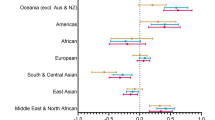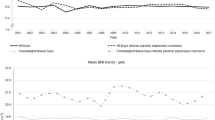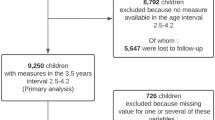Abstract
Background:
Swedish school children living in rural areas and in areas with low education are at excess risk of becoming overweight. This study examines influences of societal and individual characteristics (children and their parents) on prevalence of overweight and obesity, in a national sample of 7–9-year-old children.
Method:
Anthropometric and lifestyle data were collected in a nationally representative sample of 3636 Swedish children. Overweight and obesity (International Obesity Task Force (IOTF)) data were analyzed in relation to lifestyle factors, parental weight, education and breast-feeding.
Results:
The prevalence of overweight was 15.6% including 2.6% obese. Urbanization level and parental characteristics (weight status and education) were related to risk of overweight. Overall less favorable lifestyle characteristics were observed in rural areas and for children of low/medium educated mothers. Boys had greater risk of obesity in semi-urban and rural areas but this was not true for girls. For children’s overweight, the living area effect was attenuated in multivariate analysis, while there was an association with origin of parents, high parental weight and medium maternal education. For obesity, the living area effect remained in boys while having two non-Nordic parents predicted obesity in girls. Parental weight status was associated with obesity in both girls and boys.
Conclusion:
Individual and societal factors influence children’s weight status, and parental weight status is a strong determinant. Including overweight and obese parents in future health promoting interventions could be a strategy to prevent children from becoming overweight, but identifying those parents may prove difficult. To ensure reaching children with the greatest needs, targeting high risk areas might be a more effective approach.
This is a preview of subscription content, access via your institution
Access options
Subscribe to this journal
Receive 12 print issues and online access
$259.00 per year
only $21.58 per issue
Buy this article
- Purchase on Springer Link
- Instant access to full article PDF
Prices may be subject to local taxes which are calculated during checkout


Similar content being viewed by others
References
Melinder K . Hälsan och dess bestämningsfaktorer i olika typer av kommuner. Swedish National Institute of Public Health. Sandviken, Sweden, 2003. [In Swedish, English summary on p 6]. Available at: http://www.fhi.se/PageFiles/3167/halsansbestamning0401.pdf accessed 10 October 2011).
Sjöberg A, Moraeus L, Yngve A, Poortvliet E, Al-Ansari U, Lissner L . Overweight and obesity in a representative sample of schoolchildren - exploring the urban-rural gradient in Sweden. Obes Rev 2011; 12: 305–314.
Liu J, Bennett KJ, Harun N, Probst JC . Urban-rural differences in overweight status and physical inactivity among US children aged 10–17 years. J Rural Health 2008; 24: 407–415.
Simen-Kapeu A, Kuhle S, Veugelers PJ . Geographic differences in childhood overweight, physical activity, nutrition and neighbourhood facilities: implications for prevention. Can J Public Health 2010; 101: 128–132.
Bertoncello C, Cazzaro R, Ferraresso A, Mazzer R, Moretti G . Prevalence of overweight and obesity among school-aged children in urban, rural and mountain areas of the Veneto Region, Italy. Public Health Nutr 2008; 11: 887–890.
Bruner MW, Lawson J, Pickett W, Boyce W, Janssen I . Rural Canadian adolescents are more likely to be obese compared with urban adolescents. Int J Pediatr Obes 2008; 3: 205–211.
Binkin N, Fontana G, Lamberti A, Cattaneo C, Baglio G, Perra A et alA national survey of the prevalence of childhood overweight and obesity in Italy. Obes Rev 2010; 11: 2–10.
Juliusson PB, Eide GE, Roelants M, Waaler PE, Hauspie R, Bjerknes R . Overweight and obesity in Norwegian children: prevalence and socio-demographic risk factors. Acta Paediatr 2010; 99: 900–905.
He M, Sutton J . Using routine growth monitoring data in tracking overweight prevalence in young children. Can J Public Health 2004; 95: 419–423.
Bauer F, Elbers CC, Adan RA, Loos RJ, Onland-Moret NC, Grobbee DE et alObesity genes identified in genome-wide association studies are associated with adiposity measures and potentially with nutrient-specific food preference. Am J Clin Nutr 2009; 90: 951–959.
Sjöberg A, Lissner L, Albertsson-Wikland K, Mårild S . Recent anthropometric trends among Swedish school children: evidence for decreasing prevalence of overweight in girls. Acta Paediatr 2008; 97: 118–123.
Sundblom E, Petzold M, Rasmussen F, Callmer E, Lissner L . Childhood overweight and obesity prevalences levelling off in Stockholm but socioeconomic differences persist. Int J Obes (Lond) 2008; 32: 1525–1530.
Monasta L, Batty GD, Cattaneo A, Lutje V, Ronfani L, Van Lenthe FJ et alEarly-life determinants of overweight and obesity: a review of systematic reviews. Obes Rev 2010; 11: 695–708.
Mårild S, Bondestam M, Bergström R, Ehnberg S, Hollsing A, Albertsson-Wikland K . Prevalence trends of obesity and overweight among 10-year-old children in western Sweden and relationship with parental body mass index. Acta Paediatr 2004; 93: 1588–1595.
Burke V, Beilin LJ, Dunbar D . Family lifestyle and parental body mass index as predictors of body mass index in Australian children: a longitudinal study. Int J Obes Relat Metab Disord 2001; 25: 147–157.
Maffeis C, Talamini G, Tato L . Influence of diet, physical activity and parents' obesity on children's adiposity: a four-year longitudinal study. Int J Obes Relat Metab Disord 1998; 22: 758–764.
World Health OrganizationWHO European childhood obesity surveillance initiative (COSI). Copenhagen, Denmark, 2011. Available at: http://www.euro.who.int/en/what-we-do/health-topics/disease-prevention/nutrition/activities/monitoring-and-surveillance/who-european-childhood-obesity-surveillance-initiative-cosi (accessed 10 October 2011).
World Health Organization Physical status: the use and interpretation of anthropometry. Technical report series. No. 854. Geneva, Switzerland, 1995.
The European CommissionThe European union labour force survey. Methods and definitions - 2001 degree of urbanization pp 54–55. Luxembourg, 2003. Available at: http://epp.eurostat.ec.europa.eu/cache/ITY_OFFPUB/KS-BF-03-002/EN/KS-BF-03-002-EN.PDF (accessed 10 October 2011).
Cole TJ, Bellizzi MC, Flegal KM, Dietz WH . Establishing a standard definition for child overweight and obesity worldwide: international survey. BMJ 2000; 320: 1240–1243.
World Health OrganizationWHO Reference 2007. Growth reference data for 5–19 years. Available at: http://www.who.int/growthref/en/ (accessed 10 October 2011).
Zhang J, Yu KF . What's the relative risk? A method of correcting the odds ratio in cohort studies of common outcomes. JAMA 1998; 280: 1690–1691.
Simen-Kapeu A, Veugelers PJ . Should public health interventions aimed at reducing childhood overweight and obesity be gender-focused? BMC Public Health 2010; 10: 340.
Neovius M, Rasmussen F . Place of residence and obesity in 1,578,694 young Swedish men between 1969 and 2005. Obesity (Silver Spring) 2008; 16: 671–676.
Joens-Matre RR, Welk GJ, Calabro MA, Russell DW, Nicklay E, Hensley LD . Rural-urban differences in physical activity, physical fitness, and overweight prevalence of children. J Rural Health 2008; 24: 49–54.
Hodgkin E, Hamlin MJ, Ross JJ, Peters F . Obesity, energy intake and physical activity in rural and urban New Zealand children. Rural Remote Health 2010; 10: 1336.
Wang Y, Monteiro C, Popkin BM . Trends of obesity and underweight in older children and adolescents in the United States, Brazil, China, and Russia. Am J Clin Nutr 2002; 75: 971–977.
Ekblom Ö, Oddsson K, Ekblom B . Prevalence and regional differences in overweight in 2001 and trends in BMI distribution in Swedish children from 1987 to 2001. Scand J Public Health 2004; 32: 257–263.
Malik VS, Schulze MB, Hu FB . Intake of sugar-sweetened beverages and weight gain: a systematic review. Am J Clin Nutr 2006; 84: 274–288.
Magnusson MB, Sjöberg A, Kjellgren KI, Lissner L . Childhood obesity and prevention in different socio-economic contexts. Prev Med 2011; 53: 402–407.
Statistics SwedenLiving Conditions, Report No. 116: Children’s Leasure Time. Stockholm, Sweden, 2009 [In Swedish, summary in English on p 49]. Available at http://www.scb.se/statistik/_publikationer/LE0106_2006I07_BR_LE116BR0901.pdf (accessed 10 October 2011).
Freeman E, Fletcher R, Collins CE, Morgan PJ, Burrows T, Callister R . Preventing and treating childhood obesity: time to target fathers. Int J Obes (Lond) 2012; 36: 12–15.
Lamberti A, Buoncristiano M, Baglio G, Nardone P, Spinelli A . Obese parents are more likely to have obese children: results of the Italian national surveillance system. In: International Conference of Childhood Obesity. Instituto Nacional de Saúde: Oeiras, Portugal, 2011. p 59 Abstract T1, p 118.
Acknowledgements
This study was funded by the Swedish Research Council (2006-7777), The Swedish Council for Working Life and Social Research (2006-1624, 2006-1506) and The Lundgren Foundations. We are grateful to participating families and to statistician Valter Sundh.
Author information
Authors and Affiliations
Corresponding author
Ethics declarations
Competing interests
The authors declare no conflict of interest.
Rights and permissions
About this article
Cite this article
Moraeus, L., Lissner, L., Yngve, A. et al. Multi-level influences on childhood obesity in Sweden: societal factors, parental determinants and child’s lifestyle. Int J Obes 36, 969–976 (2012). https://doi.org/10.1038/ijo.2012.79
Received:
Revised:
Accepted:
Published:
Issue Date:
DOI: https://doi.org/10.1038/ijo.2012.79
Keywords
This article is cited by
-
Breastfeeding and overweight/obesity among children and adolescents: a cross-sectional study
BMC Pediatrics (2022)
-
Association between maternal and paternal employment and their children’s weight status and unhealthy behaviours: does it matter who the working parent is?
BMC Public Health (2022)
-
Investigation of obesity, eating behaviors and physical activity levels living in rural and urban areas during the covid-19 pandemic era: a study of Turkish adolescent
BMC Pediatrics (2022)
-
Prediction model study of overweight and obesity in preschool children with allergic diseases from an ecological perspective
BMC Pediatrics (2021)
-
Associations of community, famliy and early individual factors with body mass index z-scores trajectories among Chinese children and adolescents
Scientific Reports (2021)



